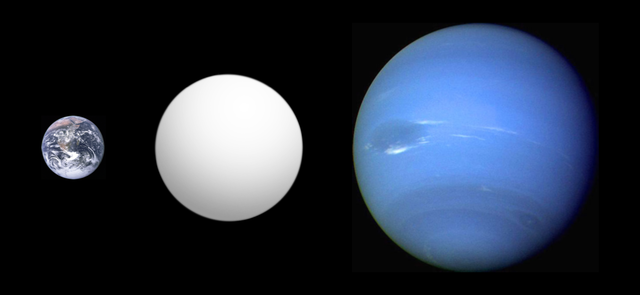Top Qs
Timeline
Chat
Perspective
Mega-Earth
Terrestrial planet over ten Earth masses From Wikipedia, the free encyclopedia
Remove ads
A mega-Earth or massive solid planet[1][2] is a proposed neologism for a massive terrestrial exoplanet that is at least ten times the mass of Earth (M🜨). Mega-Earths would be substantially more massive than super-Earths (terrestrial and ocean planets with masses around 5–10 M🜨). The term "mega-Earth" was coined in 2014, when Kepler-10c was revealed to be a Neptune-mass planet with a density considerably greater than that of Earth.[3] However, it has since been determined to be a typical volatile-rich planet weighing just under half that mass.[4]

Mega-Earths or comparable objects may exist as remnant cores of evaporated gas giants or white dwarfs,[5][6][7] and may also form around massive stars and supermassive black holes as blanets for the latter.[1][8]
Remove ads
Examples
Summarize
Perspective
Kepler-10c was the first exoplanet to be classified as a mega-Earth. At the time of its discovery, it was believed to have a mass around 17 times that of Earth (M🜨) and a radius around 2.3 times Earth's (R🜨), giving it a high density that implied a mainly rocky composition. However, several follow-up radial velocity studies produced different results for Kepler-10c's mass, all much below the original 17 M🜨 estimate. In 2017, a more careful analysis using data from multiple different telescopes and spectrographs found that Kepler-10c is more likely around 7.4 M🜨, making it a typical volatile-rich mini-Neptune and not a mega-Earth.[9][4]
K2-56b, also designated BD+20594b, is a much more likely mega-Earth,[10] with about 16 M🜨 and 2.2 R🜨. At the time of its discovery in 2016, it had the highest chance of being rocky for a planet its size, with a posterior probability that it is dense enough to be terrestrial at about 0.43. For comparison, at the time the corresponding probability for Kepler-10c was calculated as 0.1, and as 0.002 for Kepler-131b.[11]
Kepler-145b is one of the most massive planets classified as mega-Earths, with a mass of 37.1 M🜨 and a radius of 2.65 R🜨, so large that it could belong to a sub-category of mega-Earths known as "supermassive terrestrial planets" (SMTP). It likely has an Earth-like composition of rock and iron without any volatiles. A similar mega-Earth, K2-66b, has a mass of about 21.3 M🜨 and a radius of about 2.49 R🜨, and orbits a subgiant star. Its composition appears to be mainly rock with a small iron core and a relatively thin steam atmosphere.[12]
Kepler-277b and Kepler-277c are a pair of planets orbiting the same star, both thought to be mega-Earths with masses of about 87.4 M🜨 and 64.2 M🜨, and radii of about 2.92 R🜨 and 3.36 R🜨, respectively.[13]
PSR J1719−1438 b may be one of the most massive mega-Earths ever known, with a mass of about 330 M🜨 and a radius less than 4 R🜨, slightly more massive but smaller than Jupiter. It is a pulsar planet which is most likely composed largely of crystalline carbon but with a density far greater than diamond.[6][14] However, as it is a likely remnant core of a former white dwarf companion of PSR J1719−1438, it is instead considered an ultra-low-mass carbon white dwarf or object per some definitions.[15][16]
Remove ads
Origin
Summarize
Perspective
The discovery of mega-Earths had challenged planetary formation theories.[17] Formation mechanisms and the occurrence of such objects remain subjects of ongoing research and debate.[17]
Around massive stars
A 2007 study had suggested the possibility of hypothetical solid planets up to thousands of M🜨 forming around massive stars (B-type and O-type stars; 5–120 M☉).[1] The hypothesis proposed that the protoplanetary disk around such stars would contain enough heavy elements, and that high UV radiation and strong winds could photoevaporate the gas in the disk, leaving just the heavy elements. For comparison, Neptune's mass equals 17 M🜨, Jupiter has 318 M🜨. The most massive of those objects were assumed to be up to approximately 4,000 M🜨 (or 13 MJ) per the said upper mass limit used in the IAU's working definition of an exoplanet.[1] However, this limit has been debated due to no precise physical significance, with many exoplanet catalogs including objects with heavier masses, such as up to 60 MJ.[18]
Despite the suggestion of the possibility of massive solid planets, it lacks supporting evidence for planetary formation theories and was primarily based on simulating mass-radius relationships for rocky planets, without investigating whether planetary formation theories support the existence of such objects.[1] The 2007 study acknowledged that such massive exoplanets are not yet known to exist.[1] More recent research has shown that the ratio of protoplanetary disk mass to stellar mass decreases rapidly for massive stars with initial masses above 10 M☉, falling to less than 10−4.[19] Furthermore, no protoplanetary disks have been observed around O-type stars to date.[19]
Given these considerations, the formation and existence of massive solid planets around massive stars remain speculative and require further research and observational evidence.
Around supermassive black holes
Remove ads
See also
References
Further reading
External links
Wikiwand - on
Seamless Wikipedia browsing. On steroids.
Remove ads
